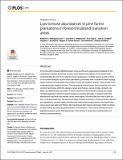Files in this item
Low tortoise abundances in pine forest plantations in forest-shrubland transition areas
Item metadata
| dc.contributor.author | Rodríguez-Caro, Roberto C. | |
| dc.contributor.author | Oedekoven, Cornelia S. | |
| dc.contributor.author | Graciá, Eva | |
| dc.contributor.author | Anadón, José D. | |
| dc.contributor.author | Buckland, Stephen T. | |
| dc.contributor.author | Esteve-Selma, Miguel A. | |
| dc.contributor.author | Martinez, Julia | |
| dc.contributor.author | Giménez, Andrés | |
| dc.date.accessioned | 2017-03-09T10:30:14Z | |
| dc.date.available | 2017-03-09T10:30:14Z | |
| dc.date.issued | 2017-03-08 | |
| dc.identifier | 249337145 | |
| dc.identifier | 16ebca5b-6836-4662-8d75-91e4342e69ec | |
| dc.identifier | 85014945929 | |
| dc.identifier | 000396073700009 | |
| dc.identifier.citation | Rodríguez-Caro , R C , Oedekoven , C S , Graciá , E , Anadón , J D , Buckland , S T , Esteve-Selma , M A , Martinez , J & Giménez , A 2017 , ' Low tortoise abundances in pine forest plantations in forest-shrubland transition areas ' , PLoS One , vol. 12 , no. 3 , e0173485 . https://doi.org/10.1371/journal.pone.0173485 | en |
| dc.identifier.issn | 1932-6203 | |
| dc.identifier.other | RIS: urn:EBB66F6BFEC8742AEE7152733B434201 | |
| dc.identifier.other | ORCID: /0000-0002-5610-7814/work/61978851 | |
| dc.identifier.other | ORCID: /0000-0002-9939-709X/work/73701050 | |
| dc.identifier.uri | https://hdl.handle.net/10023/10435 | |
| dc.description | The Spanish Ministry of Science and European Regional Development Fund funded this work through Projects CGL2012-33536 and CGL2015- 64144; MINECIO/FEDER. Regional Government of the Community of Valencia supported R.R-C. by a postgraduate grant (ACIF/2010/133) and E.G. by a postdoctoral grant (APOSTD/2015/048). | en |
| dc.description.abstract | In the transition between Mediterranean forest and the arid subtropical shrublands of the southeastern Iberian Peninsula, humans have transformed habitat since ancient times. Understanding the role of the original mosaic landscapes in wildlife species and the effects of the current changes as pine forest plantations, performed even outside the forest ecological boundaries, are important conservation issues. We studied variation in the density of the endangered spur-thighed tortoise (Testudo graeca) in three areas that include the four most common land types within the species’ range (pine forests, natural shrubs, dryland crop fields, and abandoned crop fields). Tortoise densities were estimated using a two-stage modeling approach with line transect distance sampling. Densities in dryland crop fields, abandoned crop fields and natural shrubs were higher (>6 individuals/ha) than in pine forests (1.25 individuals/ha). We also found large variation in density in the pine forests. Recent pine plantations showed higher densities than mature pine forests where shrub and herbaceous cover was taller and thicker. We hypothesize that mature pine forest might constrain tortoise activity by acting as partial barriers to movements. This issue is relevant for management purposes given that large areas in the tortoise’s range have recently been converted to pine plantations. | |
| dc.format.extent | 13 | |
| dc.format.extent | 1291788 | |
| dc.language.iso | eng | |
| dc.relation.ispartof | PLoS One | en |
| dc.subject | QH301 Biology | en |
| dc.subject | DAS | en |
| dc.subject | SDG 15 - Life on Land | en |
| dc.subject.lcc | QH301 | en |
| dc.title | Low tortoise abundances in pine forest plantations in forest-shrubland transition areas | en |
| dc.type | Journal article | en |
| dc.contributor.institution | University of St Andrews. School of Mathematics and Statistics | en |
| dc.contributor.institution | University of St Andrews. Centre for Research into Ecological & Environmental Modelling | en |
| dc.contributor.institution | University of St Andrews. Marine Alliance for Science & Technology Scotland | en |
| dc.contributor.institution | University of St Andrews. Scottish Oceans Institute | en |
| dc.contributor.institution | University of St Andrews. St Andrews Sustainability Institute | en |
| dc.identifier.doi | 10.1371/journal.pone.0173485 | |
| dc.description.status | Peer reviewed | en |
This item appears in the following Collection(s)
Items in the St Andrews Research Repository are protected by copyright, with all rights reserved, unless otherwise indicated.

